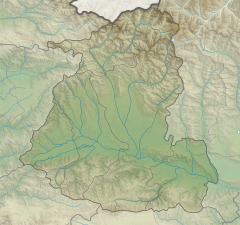
Urbnisi is a village in Georgia’s Shida Kartli region, in the district of Kareli.

Samtavisi is an eleventh-century Georgian Orthodox cathedral in eastern Georgia, in the region of Shida Kartli, some 45 km from the nation's capital Tbilisi, near Igoeti village. The cathedral is now one of the centers of the Eparchy of Samtavisi and Gori of the Georgian Orthodox Church. The church is a typical example and the founder of the Georgian interpretation of the cross-in-square churches. It was built in the period of decorative and artistic bloom in the architecture of Georgia.

The Ikorta church of the Archangel, commonly known as Ikorta (იკორთა) is a 12th-century Georgian Orthodox church located at the outskirts of the village Ikort’a in Shida Kartli region of eastern Georgia. The church was originally a part of Ikorta castle, from which only the citadel and the church remain.
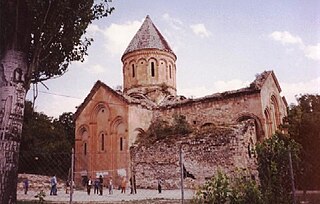
Ishkani or Ishkhan, is a ruined Christian monastery in the territory of Turkey in the village of Arpacık, Artvin province. The name Ishkhani derives from the word “Իշխան” (Ishkhan) which means “prince” in the Armenian language. It was one of the important spiritual centers in the Middle Ages Tayk/Tao-Klarjeti. Only the magnificent church and the adjacent chapel have survived. The earliest mention of the monastery is found in The Life of Grigol Khandzteli, a Georgian manuscript dating from the year 951, which is now kept in Jerusalem.
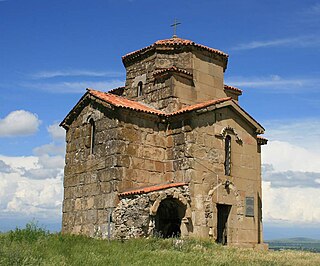
The Samtsevrisi church of Saint George is an early medieval Georgian Orthodox church in the village of Samtsevrisi, Kareli Municipality, in Georgia's region of Shida Kartli. It is a "free-cross" plan church and stylistically dated to the first half of the 7th century. The church is inscribed on the list of the Immovable Cultural Monuments of National Significance of Georgia.
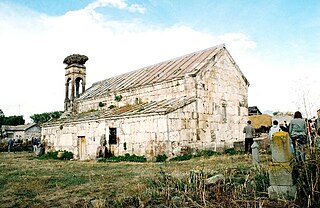
The Baraleti church of the Theotokos is a medieval Christian church in the village of Baraleti, Akhalkalaki Municipality, in Georgia's region of Samtskhe-Javakheti. The church is located in the heart of the ethnically mixed Armeno-Georgian village, in the historical province of Javakheti. It is a two-nave basilica, with the extant 13th-century inscription in Georgian. It is inscribed on the list of the Immovable Cultural Monuments of National Significance of Georgia.

The Eredvi basilica of Saint George is an early 10th-century Georgian Orthodox church in the village of Eredvi in the Shida Kartli region, currently in the disputed territory of South Ossetia. It was constructed by the architect Tevdore Taplaisdze, who laid foundation of the church in 906 as related in a Georgian inscription on the building. The church is a three-nave basilica, which, despite later reconstructions, has largely preserved its original architectural features. The church is inscribed on the list of the Immovable Cultural Monuments of National Significance of Georgia. After the 2008 Russo-Georgian War, the Georgians lost access to the church and services there were restricted by the South Ossetian authorities.
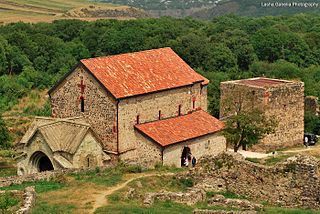
The Dmanisi cathedral of the Theotokos, commonly known as the Dmanisi Sioni church is an early medieval basilica located in the heart of the Dmanisi historic site, a ruined medieval town in Georgia's southern Kvemo Kartli region, perched on a promontory at the confluence of the Mashavera and Pinezauri rivers. The church has a three-bay nave, a prominently protruding apse, and a richly adorned narthex added in the early 13th century. The Sioni church is a functioning Georgian Orthodox church, renovated in 2009, and protected by the state as an Immovable Cultural Monument of National Significance.

The Zemo Nikozi church of the Deity, also known as Ghvtaeba (ღვთაება), is a medieval Georgian Orthodox cathedral in the Gori Municipality, in Georgia's east-central region of Shida Kartli. It is part of the complex which also includes a bell-tower, an episcopal palace, and a circuit wall. The complex is inscribed on the list of Georgia's Immovable Cultural Monuments of National Significance.
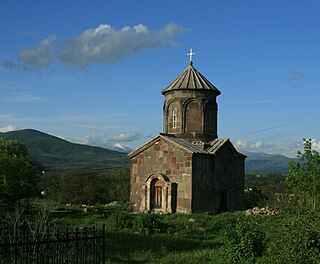
The Zemo Nikozi church of the Archangel is a 10th-century Georgian Orthodox church in the Gori Municipality, in Georgia's east-central region of Shida Kartli. It is inscribed on the list of Georgia's Immovable Cultural Monuments of National Significance.

The Tiri monastery is a 13th-century church near Tskhinvali in what is now the disputed territory of South Ossetia. Built as a Georgian Orthodox monastery in a hall church plan, it bears medieval frescoes and Georgian inscriptions. After the 2008 Russo-Georgian War, the Georgians lost access to the monastery. In 2015, the church building was subjected to maintenance works which infringed on authenticity and partially damaged the frescoes, leading to a controversy in Tskhinvali and protests from Georgia. The monastery is inscribed on the list of Georgia's Immovable Cultural Monuments of National Significance.

The Cheremi historic site is a historic and archaeological site in eastern Georgia, situated in and around the modern village of Cheremi, Gurjaani Municipality, in the region of Kakheti. The site encompasses the ruins of churches, a castle with a circuit wall, and burials. Parts of these ruins correspond to the extinct town of Cheremi known from the early medieval Georgian chronicles and are inscribed on the list of the Immovable Cultural Monuments of National Significance.

The Tsilkani cathedral of the Mother of God is a Georgian Orthodox church in the village of Tsilkani, Mtskheta Municipality, in Georgia's eastern region of Mtskheta-Mtianeti. Originally built in the 4th century, the church was repeatedly remodeled in the Middle Ages. The extant edifice is a domed cross-in-square design, contained in a walled enclosure with corner towers. It is inscribed on the list of the Immovable Cultural Monuments of National Significance.

Aghaiani church of Saint Nino is an early medieval Georgian Orthodox church on Mount Tkhoti, 2 km southeast of the village of Aghaiani in the Kaspi Municipality in Georgia's Shida Kartli region. It stands at the place of one of the three wooden crosses erected—according to historical tradition—at the behest of Saint Nino to mark adoption of Christianity by the people of Kartli. The extant structure is a hall church, a 9th–10th-century remodeling of an earlier cross-in-square building. The church is inscribed on the list of Georgia's Immovable Cultural Monuments of National Significance.

The Tsirkoli church of the Mother of God is an 8th–9th-century Georgian Orthodox church near the village of Tsirkoli in the Ksani river valley. It combines the features of domeless and domed church designs and is classified as belonging to the "transitional period" of medieval Georgian architecture. The area, part of the Akhalgori Municipality, came under the control of Russian and South Ossetian forces in the August 2008 Russo-Georgian War. As a result the Georgian clergy and parish lost access to the church, which is inscribed on Georgia's Immovable Cultural Monuments of National Significance.

The Pavnisi church of Saint George is a Georgian Orthodox church in the Kaspi Municipality in Georgia's east-central region of Shida Kartli. It is a hall church dated to the 9th–10th-century. The church is known for its frescoes dated to the latter half of the 12th century. The church is inscribed on the list of Georgia's Immovable Cultural Monuments of National Significance.

The Ikvi church of Saint George is a Georgian Orthodox church in the Kaspi Municipality in Georgia's east-central region of Shida Kartli. It is a cross-in-square church dated to the 11th century. The church is known for its elaborate decorative external stone carvings and the 12th–13th-century frescoes, being restored after rainfall damage in 2011. The church is inscribed on the list of Georgia's Immovable Cultural Monuments of National Significance.

The Urbnisi cathedral of Saint Stephen the Protomartyr, commonly known as the Sioni church of Urbnisi, is a Georgian Orthodox cathedral at the village of Urbnisi in Georgia's east-central Shida Kartli region. The church is a relatively large three-nave basilica, originally built in the 6th century and reconstructed in the 10th and 17th centuries. The church walls bear several inscriptions, some being among the oldest executed in the Georgian alphabet. The cathedral is inscribed on the list of Georgia's Immovable Cultural Monuments of National Significance.

The Khirsa monastery of Saint Stephen is a Georgian Orthodox monastery in the eastern Georgian region of Kakheti. The foundation of the monastery is credited by historical tradition to the monk Stephen, one of the Thirteen Assyrian Fathers active in the 6th century. The extant edifice, a domed church, is the result of a series of reconstructions between 886 and 1822. It is inscribed on the list of the Immovable Cultural Monuments of National Significance of Georgia.

Samshvilde Sioni church is a ruined medieval Christian cathedral and one of the main architectural features of the historic site of Samshvilde in Georgia's southern region of Kvemo Kartli. A centralized domed building with apsed sanctuary and pastophoria, the church was built between 759 and 777. It is now in ruins and only fragments of the eastern wall remain standing. The church is inscribed on the list of the Immovable Cultural Monuments of National Significance of Georgia.

